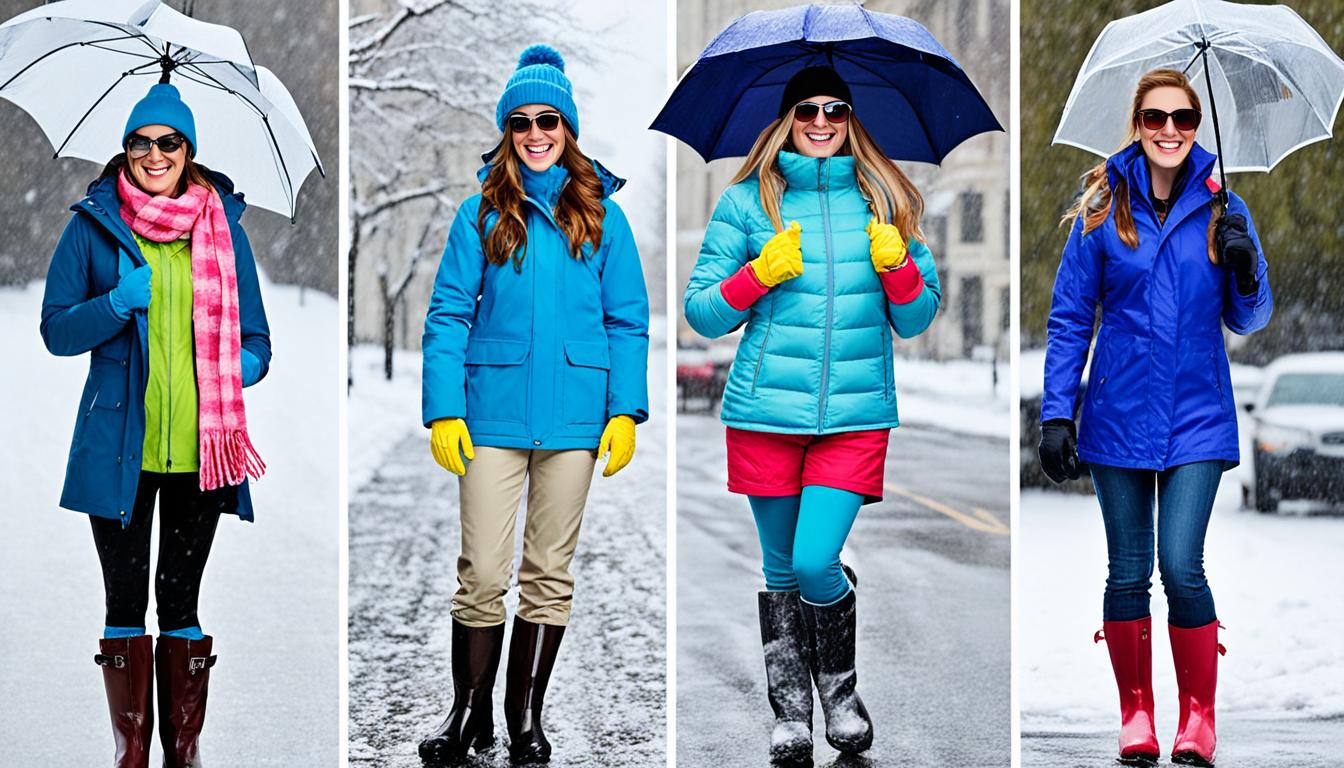When it comes to dressing for different weather conditions, it’s essential to be prepared and stylish. No one wants to be caught in the rain without an umbrella or shivering in the cold without a warm coat. In this section, we will provide practical fashion tips and essential wardrobe advice on how to dress appropriately for different weather conditions. Whether you’re facing scorching heat, chilly winds, or unpredictable weather shifts, we’ve got you covered with expert suggestions to help you navigate any weather situation.
From hot summer days to chilly winter nights, we’ll guide you through the dos and don’ts of dressing right for the elements. No more sacrificing comfort for style or vice versa. We believe that you can look fashionable and feel comfortable no matter the weather.
Whether you’re planning a beach vacation, gearing up for a winter adventure, or simply dressing for your daily routines, our tips and essentials will ensure that your outfit is both weather-appropriate and trendy. So, before you step out the door, make sure you’re dressed to conquer any climate.
Dressing for Hot Weather
When the sun is blazing and temperatures soar, dressing wisely becomes crucial to beat the heat. Whether you’re planning a beach day, engaging in outdoor activities, or simply navigating the city streets during scorching summers, we’ve got the perfect hot weather dressing tips for you.
Choosing the right fabrics is essential to staying cool and comfortable. Opt for lightweight and breathable materials like cotton, linen, or chambray. These fabrics allow air circulation and prevent excessive sweating, helping you stay fresh throughout the day.
Additionally, selecting the right style of clothing can make a significant difference in hot weather. Loose-fitting garments like flowy sundresses, relaxed-fit shorts, and airy maxi skirts not only provide comfort but also allow better airflow, keeping you cool and preventing heat rashes.
Accessorizing in hot weather can be both functional and stylish. Wear a wide-brimmed hat to shield your face from the sun’s rays. Choose sunglasses with UV protection to safeguard your eyes. Opt for open-toe sandals or breathable sneakers to let your feet breathe. Carry a lightweight and spacious tote bag to store your essentials while you’re out and about.
In the image below, you can find some inspiration for stylish and appropriate hot weather outfits:

Remember, staying hydrated is crucial, so don’t forget to carry a reusable water bottle wherever you go. Dressing for hot weather doesn’t mean compromising on style. By following these tips and incorporating your personal fashion preferences, you can create ensembles that are both fashionable and comfortable, allowing you to enjoy the summer sun to the fullest.
Dressing for Cold Weather
When the temperature drops and frost starts to bite, it’s important to know how to dress for cold weather to keep yourself warm and cozy. Whether you’re braving winter storms or enjoying crisp autumn days, our expert tips will help you stay stylish and snug during chilly weather.
One key aspect of cold weather dressing is effective layering. Layering allows you to adjust your clothing to different temperatures throughout the day, keeping you comfortable and protected. Start with a moisture-wicking base layer that will keep you dry by pulling sweat away from your body. Over that, add a insulating midlayer made from cozy fabrics like wool or fleece. Finally, top it off with a weather-resistant outer layer, such as a waterproof jacket or a warm parka, to shield you from wind, rain, and snow.
Choosing the right fabrics is also crucial for cold weather outfits. Opt for materials that offer insulation and retain heat, such as wool, down, or thermal fabrics. These fabrics trap warm air close to your body and keep cold air out. Don’t forget to protect your extremities as well – invest in a good pair of gloves, a hat, and a scarf to keep your head, hands, and neck warm.
When it comes to choosing footwear for cold weather, prioritize warmth and traction. Look for boots that are lined with insulated materials like faux fur or shearling and have a sturdy, grippy sole to prevent slipping on icy surfaces. Consider investing in waterproof or water-resistant boots to keep your feet dry in wet and snowy conditions.
Remember that cold weather dressing doesn’t have to sacrifice style. With the right combination of layers and fabrics, you can create fashionable and functional outfits. Experiment with different textures, patterns, and colors to add interest to your cold weather wardrobe. Don’t be afraid to accessorize with cozy scarves, stylish beanies, or statement gloves to elevate your look.
So, whether you’re trekking through a winter wonderland or heading out for a chilly autumn stroll, follow our expert tips for dressing for cold weather and stay warm without compromising on style.
Dressing for Variable Weather Conditions
When it comes to variable weather conditions like unpredictable spring or fall weather, getting dressed in the morning can be a real challenge. One moment it’s sunny and warm, and the next, you’re facing a sudden downpour or a chilly breeze. But fear not, we’ve got you covered with some practical tips to help you navigate these ever-changing elements.
Layering is key when it comes to dressing for variable weather. By wearing multiple layers, you can easily adapt to fluctuating temperatures throughout the day. Start with a lightweight base layer, such as a breathable cotton or moisture-wicking fabric, and add a mid-layer that provides insulation, like a thin sweater or cardigan. Finally, top it off with a versatile outer layer that can be easily removed or added as needed, such as a waterproof jacket or a stylish trench coat.
Another smart strategy is to incorporate versatile pieces into your outfit. Opt for clothing items that can easily transition from warmer to cooler weather with a few styling tweaks. For example, a maxi dress can be paired with a denim jacket or a lightweight scarf when the temperature drops, while a pair of ankle boots can be worn with dresses or shorts to add warmth and style.
Lastly, always be prepared for sudden changes in weather by carrying essential outerwear. Keep a compact umbrella in your bag or car to shield yourself from unexpected rain showers, and have a lightweight, packable puffer jacket or a cozy wrap on hand for when the temperature unexpectedly drops.






